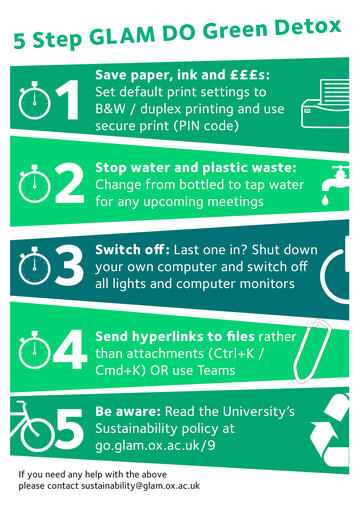Oxford University’s Gardens, Libraries and Museums (GLAM) contain some of the world's most significant and intriguing collections. From the art and archaeological treasures of the Ashmolean and the vast collections of the Bodleian Libraries, to the intricate and ingenious wonders of the History of Science Museum and the fabulous flora and fauna of the Botanic Garden and Arboretum; and from the Museum of Natural History’s cathedral of science and the magical cornucopia of the Pitt Rivers Museum. In the GLAM Divisional Office (GLAM DO), we are lucky enough to work across all six institutions.
Back in January 2020, a small group of enthusiastic colleagues came together to form the GLAM DO Sustainability Team. Our aim is to help make both our working and home environments greener and more sustainable places, and to start creating real change across the Division. Our first goal was to achieve a Green Impact Bronze Award for the GLAM Divisional Office.
When our beautiful buildings were closed in March because of COVID-19 and we started to work from home, the team continued to work together to achieve Bronze, aided by the many useful collaborative features of Teams. We were thrilled to hear in September that we had achieved our goal. In addition to winning a Bronze Award in a relatively short space of time, our biggest achievement has been working together in a very positive and creative way, to develop and implement initiatives to encourage colleagues to take part in green impact actions. These included:

- An ‘imperfect vegan day’, based on the idea that we don’t need a handful of people to do veganism perfectly; we need millions of people doing it imperfectly;
- The ‘power meter challenge’ to monitor our energy consumption at home throughout the working week;
- A ‘Green Spring Clean’ campaign (curtailed due to coronavirus) including a ‘5 steps to a green detox’ infographic (pictured right);
- A ‘daily nature walks’ channel in our Divisional Office Team in which we encouraged colleagues to share their favourite photos from their daily lockdown walk – the best image was featured in the weekly Divisional Office newsletter;
- We also got involved with plastic-free July.
For some of us, the changes made during these actions have been long lasting, from buying toothpaste in jars to baking our own biscuits (for the good of the planet, honest!).
One of our functions as the Divisional Office is to create connections and enable collaborations between our gardens, libraries and museums. When thinking ahead to achieve our next Green Impact award, we plan to help connect the seven GLAM departments (including the Divisional Office), in order to share knowledge and best practice around sustainability, and to collaborate on joint projects across the departments.
Some projects which are already underway or in the pipeline include:
- Transition to an electric vehicle for the Gardens & Museums IT Team;
- Improving our IT cooling efficiencies with rack cooling instead of using room air conditioning;
- A solar-powered public wireless solution at Harcourt Arboretum to widen our reach;
- A strategy to deliver a Carbon Neutral Infrastructure;
- A mapping of sustainability activity across GLAM and development of shared resources;
- Additional work with our community engagement team to engage our team of 800+ volunteers with sustainability issues.
The benefits of working across GLAM will be the passion, expertise and collective insight of our colleagues, and the willingness to embrace change. The challenges we envisage include working in old, often listed buildings and sites, and how to join up the many moving parts, which will enable our wonderful gardens, libraries and museums to function in the most environmentally sustainable ways possible.
Written by Emma Webster; Photos by Hayleigh Juston and Kevin Rodd